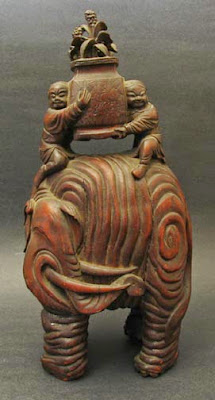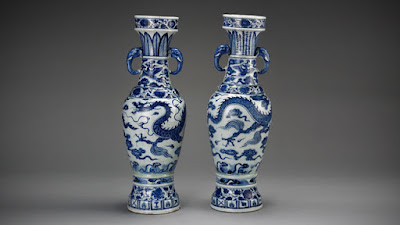Chinese Elephant found in a North Shore House, Fine 18th C. Qianlong Bamboo Carving of an Elephant
Chinese Elephant found in a North Shore House, Fine 18th C. Qianlong Bamboo Carving of an Elephant
Over the years many interesting things of terrific quality have come from old estates here on Boston's North Shore. We are always seeking collections and single items.
From Shanghai to Beverly Farms
 |
| 18thC. Qianlong Period Carved Bamboo Elephant |
From 1899 to the 1920's years Asia saw a large influx of foreign diplomats entering China to build relations and to keep an eye on investments made there by many nations while the country went through a series of leaders and economic turmoil. While westerners lived much of the time like royalty, the rest of China was heading into an uprising and major political turmoil.
Also during this time well to do Americans, many from New England, serving there built large houses and furnished them with superb examples of Chinese antiques being sold at bargain prices due to the weak economy. Many fine collections were begun during this time, much of brought/sent back to the USA through these three decades.
Bamboo Carving in China, a really quick History
The artistic carving of Bamboo in China initially got it's start during the early Ming Dynasty (1368-1644), previously it had been used for over 1500 years as a material used almost for strictly utilitarian objects starting around 200 BC during the Western Han Dynasty (206BC-AD24). Making water scoops, spoons, baskets were among just a few of the earliest wares, these items have since been found over the years within excavated tombs.
 |
| Western Han Jade Carving |
By the start of the Qing Dynasty dozens of types of carving had been and continued to be developed by thousands of artisans living mostly in either Jiading in Shanghai and Baoqing in the Hunan Province. Innovative styles were made changing the very texture of the appearance of the Bamboo itself.
The Elephant in Beverly-Farms
 |
| 18th C. Qianlong Period Carved Bamboo Elephant detail |
Eventually, animal forms in Bamboo began to appear in larger forms including this Elephant statue, which measured over 12" tall, it came from one big Bamboo Tree. Most notable about these 18th C. carvings, starting with the Kangxi Period (1662-1722), artists seem to pay greater and greater attention to the facial expressions of people, mammals, birds, reptiles and mythical beasts in their work. This elephant is no exception nor are the riders clutching a flower planter. Note how the face and eyes look on the creature, this expression was used over and over by artists in carvings as well as paintings on silk and porcelains. In order to accommodate the size of the Bamboo stalk being used the end result is an elongated figure giving the pachyderm a compressed appearance.
 |
| 18th C. Qianlong Period Carved Bamboo Elephant detail |
By the mid 18thC during the Qinalong period "modern" Chinese art reached an apex under the encouragement of the Emperor. He was himself an artist and a rabid collector who provided astronomical sums of money for the arts to expand. At this time, the Qianlong Emperor was by far the wealthiest man on earth, consequently the amount of art, Imperial; porcelain, jade, paintings, glass, bronzes, poetry on silk and too many combinations of all forms to count were executed.
 |
| 18th C. Qianlong Period Carved Bamboo Elephant, rear view |
Just one of the amazing aspects of the tradition of Chinese carving was how masterfully carvers incorporated the various limits imposed on them by the shapes of the raw materials being used to create the end result they wanted. Bamboo carving was no exception.
Feel free to email or call with any questions about your own Bamboo Carvings, Chinese Silks, Porcelains or Jades or their values.
Thank you for visiting ~ Peter Combs
Gloucester, MA 978-283-3524
Feel free to email or call with any questions about your own Bamboo Carvings, Chinese Silks, Porcelains or Jades or their values.
Thank you for visiting ~ Peter Combs
Gloucester, MA 978-283-3524


Comments
Post a Comment
If you have any questions or comments please send us a message. Or use the Contact Us tab at the top of the page.